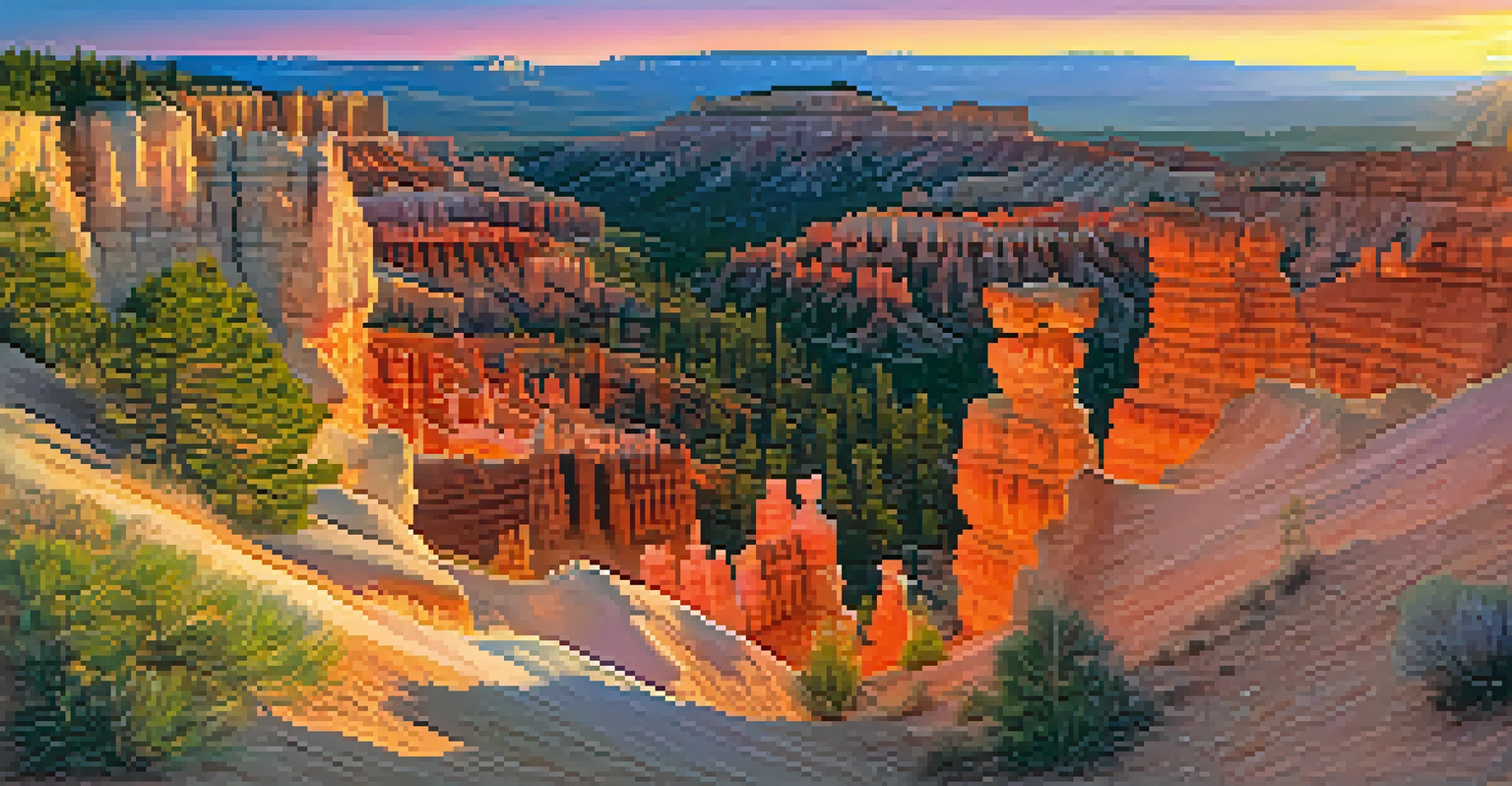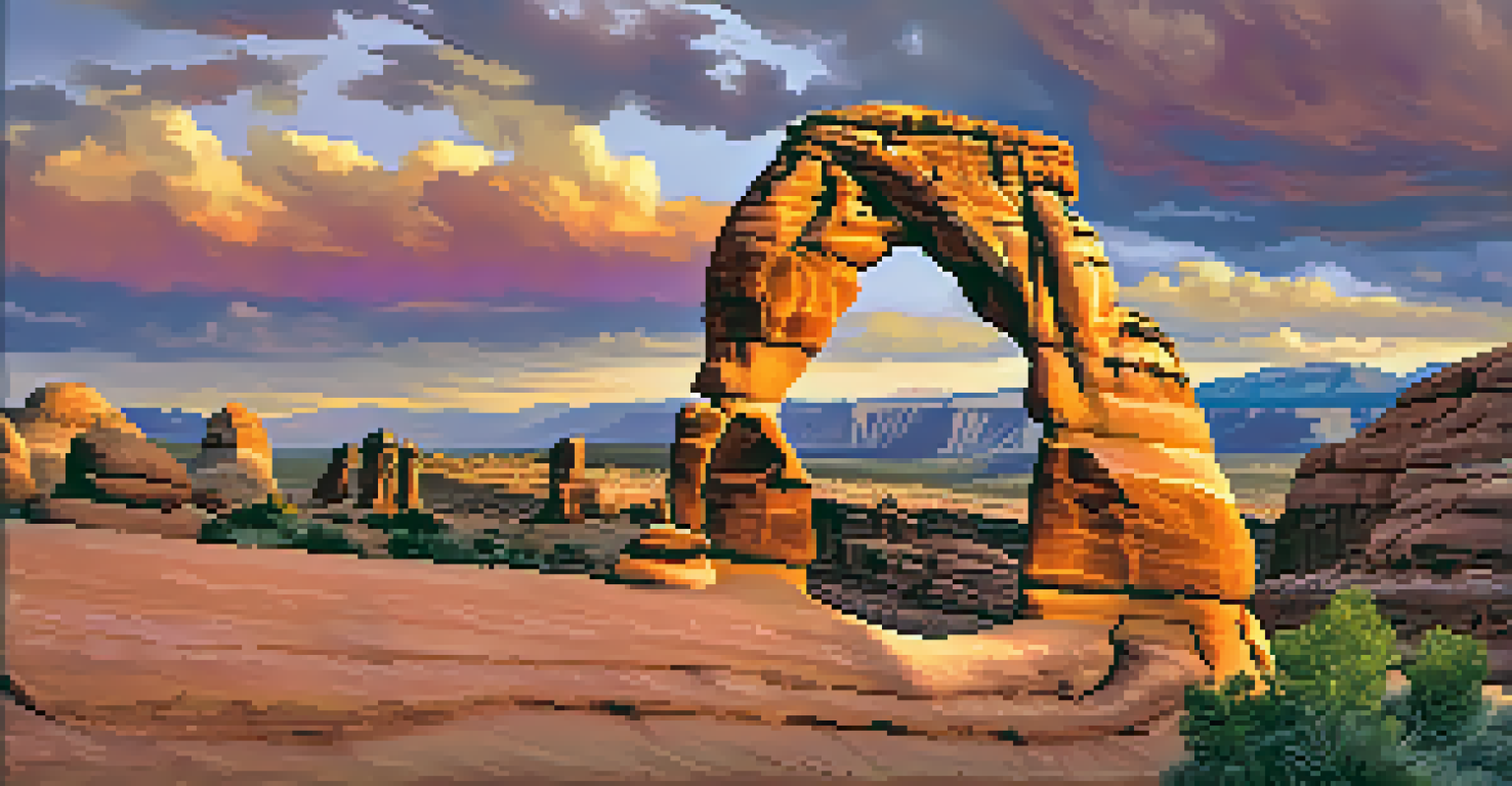Utah's National Parks: A Showcase of Landform Diversity

An Overview of Utah's National Parks: A Unique Collection
Utah is home to five magnificent national parks, each showcasing its own distinct beauty and geological features. From the towering cliffs of Zion to the otherworldly formations of Arches, these parks offer a visual feast for nature lovers and adventure seekers alike. Together, they form a stunning collection known as the 'Mighty 5,' drawing millions of visitors each year to explore their diverse landscapes.
In every walk with nature one receives far more than he seeks.
These parks are more than just pretty backdrops; they are living classrooms, teaching us about the earth's history through their unique landforms. For instance, the vibrant red rock formations found in Canyonlands tell a story of erosion and time, while the delicate arches in Arches National Park reveal the power of natural forces at play. Each park tells a tale that is both ancient and ongoing.
Visiting these parks is an opportunity to connect with nature and appreciate the incredible diversity of our planet. Whether you’re hiking in Bryce Canyon or stargazing in Capitol Reef, each experience highlights the unique characteristics that make Utah's national parks a treasure trove of natural wonder.
Zion National Park: A Majestic Canyon Experience
Zion National Park is often the first stop for many visitors, and for good reason. The park is famous for its steep red cliffs, lush canyons, and the winding Virgin River, which all create a breathtaking landscape that feels like stepping into a painting. The iconic Angels Landing trail offers an exhilarating hike with views that will leave you in awe.

The park is also home to a variety of ecosystems, from desert to riparian zones, making it a haven for wildlife. Keep an eye out for bighorn sheep and the elusive mountain lion as you explore the trails. This diversity of life is a testament to the unique climate and geography of Zion, providing visitors with a rich experience in nature.
Explore Utah's Mighty 5 National Parks
Utah's five national parks offer diverse landscapes and unique geological features, making them a must-visit for nature lovers and adventurers.
For those looking for a more leisurely visit, the scenic drive through the park showcases its stunning formations, such as the Great White Throne and the Temple of Sinawava. Whether you’re seeking adventure or relaxation, Zion National Park caters to every type of traveler, making it a must-see on your Utah journey.
Bryce Canyon National Park: The Land of Hoodoos
Bryce Canyon is renowned for its unique geological structures known as hoodoos—tall, thin spires of rock that create a whimsical landscape. The park’s vibrant orange and red hues come alive, especially at sunrise and sunset, providing photographers with stunning opportunities. Walking along the rim or hiking into the canyon allows you to appreciate these natural wonders up close.
The mountains are calling and I must go.
Interestingly, Bryce Canyon is not actually a canyon but a series of amphitheaters formed by erosion. The interplay of frost and thaw cycles has sculpted these extraordinary formations over thousands of years. This process continues today, making each visit a chance to witness a constantly evolving landscape.
The park also offers numerous trails, such as the Queen's Garden Trail, which leads you through the hoodoos and provides a different perspective of their grandeur. With its dramatic scenery and unique geological features, Bryce Canyon is a surreal experience that leaves a lasting impression on all who visit.
Arches National Park: A Gallery of Natural Arches
Arches National Park is famous for its incredible natural arches, with over 2,000 documented throughout the park. Each arch, formed through a combination of erosion and weathering, tells a story of the forces that shape our planet. Delicate Arch is the park's most iconic structure, often featured in photographs and postcards, and is a must-see for visitors.
The landscape here is characterized by striking red rocks and contrasting blue skies, creating a stunning backdrop for exploration. Hiking through the park, you can witness arches like Landscape Arch and Double Arch, each with its own unique characteristics. It’s almost as if you’re walking through a natural art gallery, where each piece is a testament to the power of nature.
Zion: A Blend of Adventure and Nature
Zion National Park captivates visitors with its stunning red cliffs, rich wildlife, and a variety of trails for both adventure seekers and leisurely explorers.
Beyond the arches, the park's diverse ecosystems support a variety of wildlife, making it a great spot for birdwatching and nature photography. The combination of geological wonders and vibrant life makes Arches National Park a truly unforgettable destination for anyone looking to experience the beauty of nature.
Canyonlands National Park: A Vast Wilderness of Contrasts
Canyonlands National Park offers a dramatic contrast of canyons, mesas, and buttes, providing visitors with a sense of vastness that is hard to describe. The park is divided into four districts—Island in the Sky, The Needles, The Maze, and the rivers—each offering unique perspectives on its rugged beauty. This diverse landscape is a playground for adventurers and a paradise for those seeking solitude.
The Island in the Sky district is particularly popular for its breathtaking overlooks, where you can see the confluence of the Colorado and Green Rivers. The Needles, with its colorful spires and intricate rock formations, invites hikers to explore its many trails. Each district showcases the park's rich geological history, shaped by water and wind over millions of years.
Canyonlands is also a great spot for stargazing, as the remote location offers some of the darkest skies in the country. As you gaze up at the stars, it’s a humbling reminder of the vastness of the universe and our place within it. This blend of adventure, beauty, and tranquility makes Canyonlands National Park a highlight of any Utah trip.
Capitol Reef National Park: A Hidden Gem of Diversity
Capitol Reef National Park is often overshadowed by its more famous neighbors, but it offers an incredible array of landscapes and history. The park features impressive cliffs, canyons, and the Waterpocket Fold, a nearly 100-mile long warp in the Earth's crust. This unique geological feature creates a stunning backdrop for exploration and discovery.
The rich history of Capitol Reef is evident through its ancient petroglyphs and the remnants of pioneer settlements, adding a cultural layer to your visit. The Fruita area, with its historic orchards, invites you to pick fresh fruit during the summer months, creating a delightful experience that combines nature and agriculture. It’s a charming reminder of the resilience of those who settled in this rugged landscape.
Capitol Reef: A Hidden Gem to Discover
Capitol Reef National Park stands out with its unique geological formations, rich history, and less crowded trails, providing an intimate experience with nature.
With its less crowded trails and diverse scenery, Capitol Reef offers a more intimate experience with nature. Whether you’re hiking to Cassidy Arch or exploring the scenic drive, the park captivates with its beauty and tranquility. It’s a hidden gem that deserves a spot on your Utah itinerary, promising an adventure off the beaten path.
Tips for Visiting Utah's National Parks: Making the Most of Your Trip
When planning your visit to Utah's national parks, timing is crucial. Spring and fall are ideal for comfortable temperatures and fewer crowds, allowing you to fully enjoy the natural beauty without feeling rushed. Additionally, many parks offer ranger-led programs that provide insights into the geology and history of the area, enhancing your experience.
Be sure to pack plenty of water, sun protection, and sturdy footwear, as many trails can be challenging. Each park has its own unique climate, so checking the weather before your visit is essential. Remember, respecting the natural environment by sticking to established trails helps preserve these stunning landscapes for future generations.

Lastly, consider purchasing an America the Beautiful Pass if you plan to visit multiple parks. This pass grants you access to all national parks and federal recreation lands, making it a cost-effective choice for park enthusiasts. With careful planning and a spirit of adventure, your trip to Utah's national parks will be an unforgettable journey through stunning landscapes.